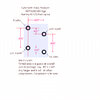Vons Garage
New Member
Issue: Device will not store messages after power off.
Good day.

This LED sign is touted as having “a rechargeable battery for memory backup … for at least 3 months”. As there are zero batteries in this thing, near as I can figure they are using a 17,000 mfd cap as the “rechargeable” battery. This part was recently replaced and still no memory storage.
You guys are the pros. Can a 17,000 mfd cap allow an RCA CDM6116E2 CMOS 2048-Word by 8-bit LSI Static RAM keeps it’s programming for 3 months?
Or were the sales team and manual writers thinking of a future unit; perhaps the one that member “slywuf” inquired about back in 01/29/2019? That sign looks way different than my fellow. And I can see a great big Panasonic battery on his motherboard, wear as mine has the cap wired-in way back prior to the power supply.

And for future reference; I have included a manual that I rewrote for this sign for those that may find it handy.
Good day.
This LED sign is touted as having “a rechargeable battery for memory backup … for at least 3 months”. As there are zero batteries in this thing, near as I can figure they are using a 17,000 mfd cap as the “rechargeable” battery. This part was recently replaced and still no memory storage.
You guys are the pros. Can a 17,000 mfd cap allow an RCA CDM6116E2 CMOS 2048-Word by 8-bit LSI Static RAM keeps it’s programming for 3 months?
Or were the sales team and manual writers thinking of a future unit; perhaps the one that member “slywuf” inquired about back in 01/29/2019? That sign looks way different than my fellow. And I can see a great big Panasonic battery on his motherboard, wear as mine has the cap wired-in way back prior to the power supply.
And for future reference; I have included a manual that I rewrote for this sign for those that may find it handy.


